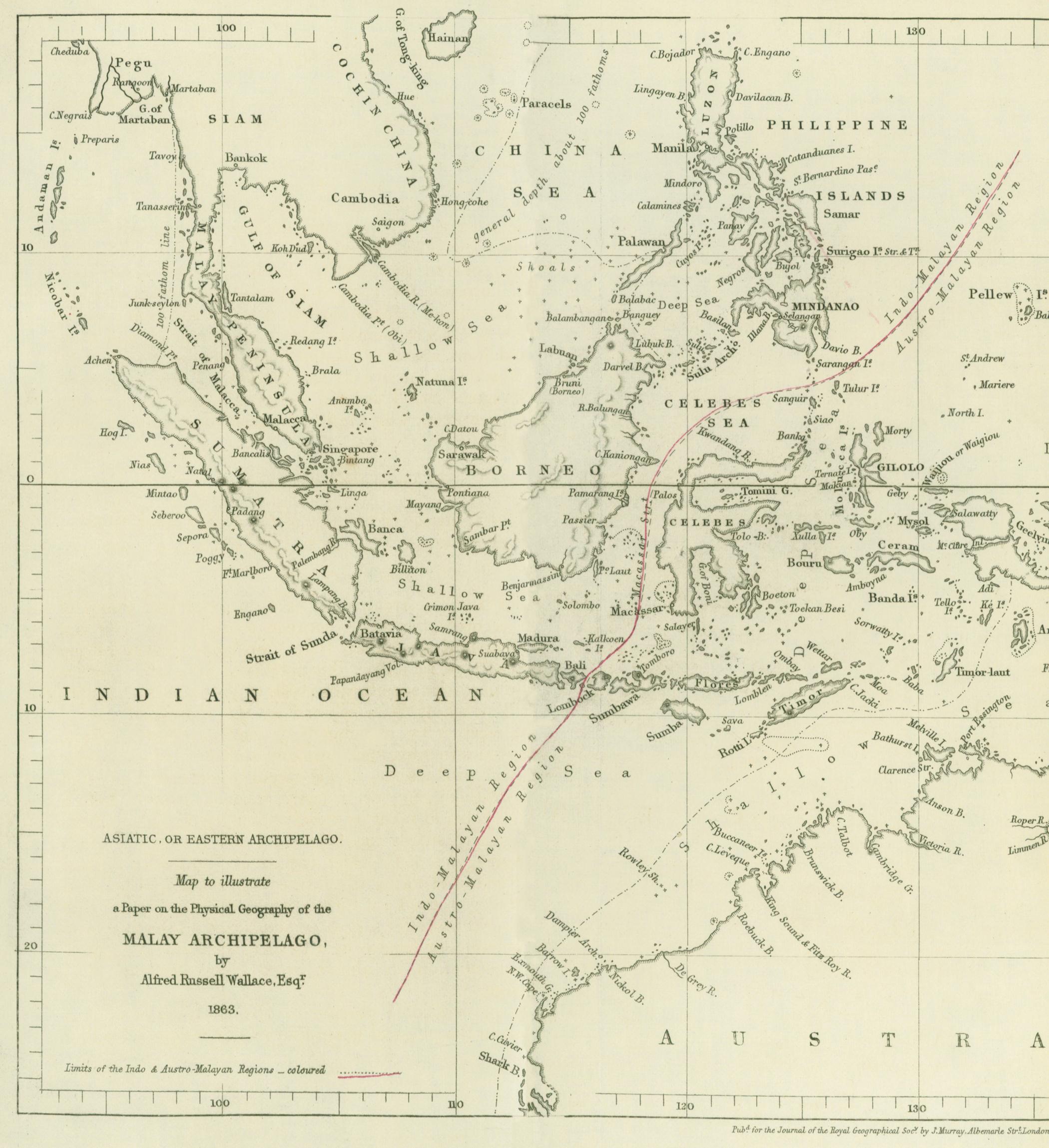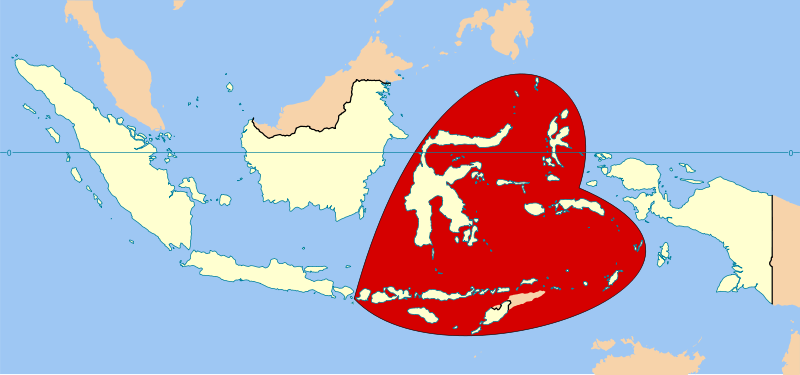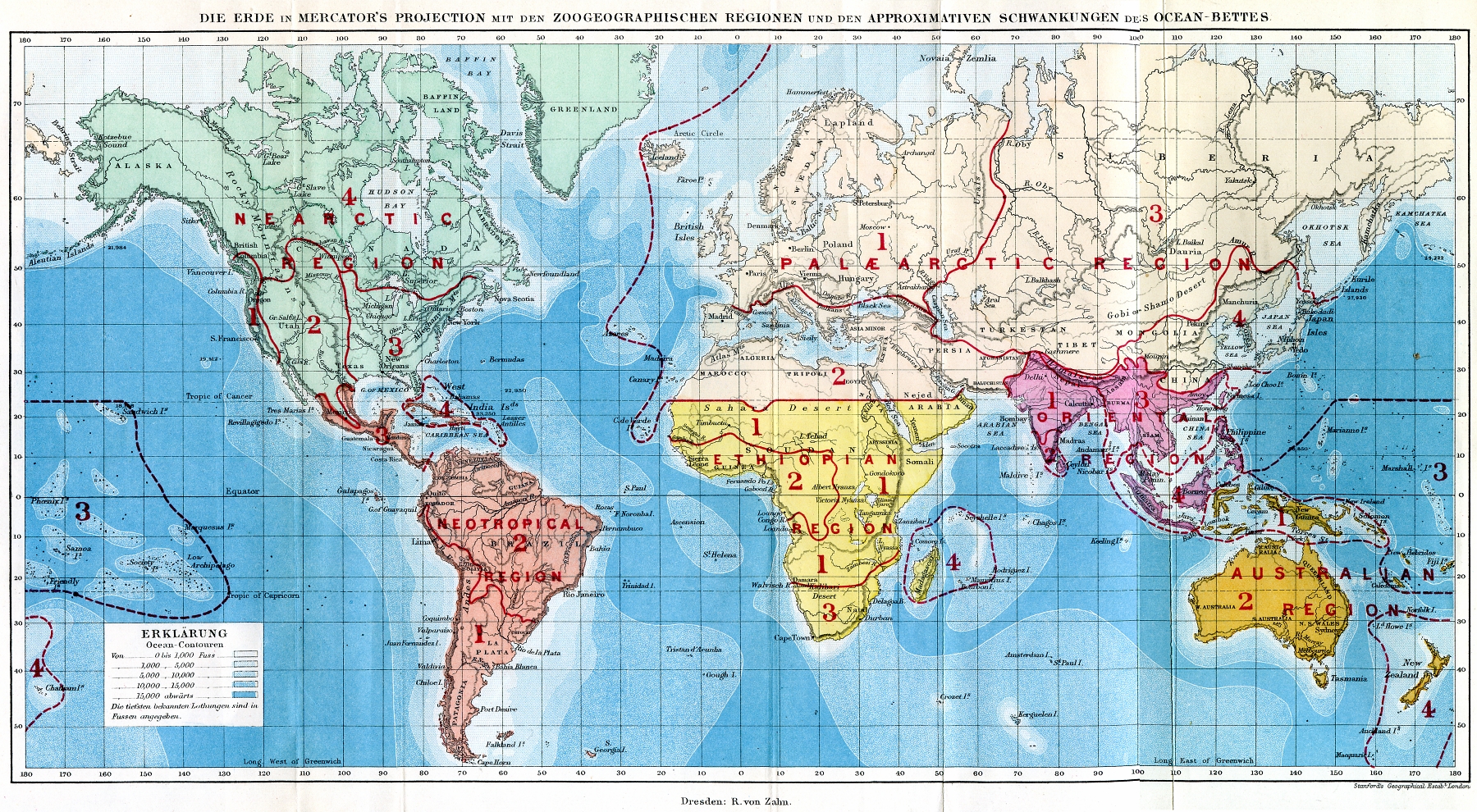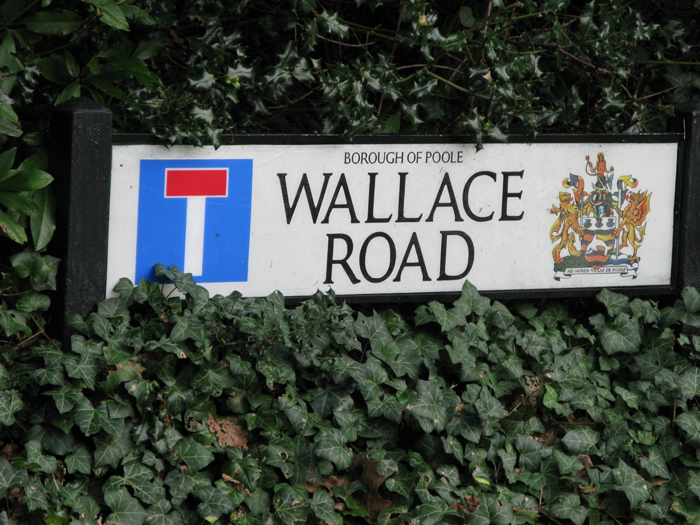By George Beccaloni & Charles Smith
- "Wallace's Line" is an invisible boundary that separates the zoogeographical regions of Asia (to the west of it) and Australasia (to the east). The line runs through the Lombok Strait between the islands of Bali and Lombok, then up between Borneo and Sulawesi, and from there continues northward to separate the Philippine island of Mindanao from the small islands of Sangir and Talaud that lie south of it. The significance of the line is that it identifies a major (though not entirely abrupt) faunal discontinuity: many major groups found to the west of the line do not extend east of it, and vice versa. The deep water of the Lombok Strait between the islands of Bali and Lombok formed a water barrier even when lower sea levels linked the now-separated islands and landmasses on either side, resulting in the isolation of the faunas on either side of the barrier.

The original map of the Wallace Line (in red) from Wallace's 1863 paper "On the Physical Geography of the Malay Archipelago" [from Wikipedia].
- "Wallacea" or the "Wallacean region" is the name of the transitional zone between the Oriental and Australian zoogeographical regions. Wallacea encompasses islands which never had dry land connections to the main land masses of either south-east Asia or Australasia. Consequently it has few animals which find it difficult to cross stretches of open ocean (e.g. land mammals, land birds, or freshwater fish of continental origin).

Map showing the position of the Wallacean region (area in red) [from Wikipedia]
- "Wallace's realms" are the world's six basic zoogeographical regions.

Map from Wallace's book The Geographical Distribution of Animals showing the world divided into zoogeographic regions [from Wikipedia].
- "Wallacean shortfall" is a term coined by Lomolino (2004) to describe the current lack of information about the geographical distributions of most species.
- ‘wallaces‘ (wa) are a unit used to quantify the biogeographical dispersal rate of species.
- The "Wallace-Weismann hypothesis" is a name sometimes given to the idea that death in individual organisms is programmed, representing an adaptive strategy.
- The "Wallace Effect" concerns the relation of reproductive isolation to the production of sterile hybrids (and ultimately to the speciation process).
- "Wallacean sexual selection" is a term given to
- A 26 km meteor crater on the Moon was named "Wallace" in 1935. It is situated in the Mare Imbrium lava plain
- A 173 km crater on Mars was named "Wallace" in 1973. Its coordinates are 52.9°S 249.4°W.
- "Mt. Wallace" (13,377 ft.), named by Theodore S. Solomons in 1895, is one of the "Evolution Group" peaks of the Sierra Nevada in California
- The "Wallace Trench" is an undersea chasm located between New Guinea/Australia and Java/Borneo and nearly 7,500 m (25,000 ft) deep. It was not breached during periods of lowered Pleistocene sea levels, so population movement from southeast Asia to Sahul was accomplished, of necessity, via water.
- An undersea hill in the Indian Ocean north of Madagascar (3°25.7'S, 56°40.8'E) was named Wallace Hill in November 2003 by Robert Whitmarsh, University of South Hampton, UK, and accredited by SCUFN in May 2004 (see http://ebookily.org/xls/gebco-gazetteer-of-ufn-general-bathymetric-chart-of-the-oceans-8765808.html).
- Bristol Zoo Gardens in Bristol, U.K. has a large open air walk-through aviary named the "Wallace Aviary"
- The Department of Earth Sciences at Cardiff University, Wales has a "Wallace Lecture Theatre"
- Bournemouth University in Bournemouth, UK has a "Wallace Lecture Theatre"
- Swansea University has a "Wallace Lecture Theatre"
- The National Botanic Garden of Wales, near Carmarthen, Wales has a "Wallace Garden" dedicated to genetics and evolution education
- Bournemouth Natural Sciences Society (of which Wallace was a founder) has a "Wallace Room"
- Richard Hale School (formerly the Hertford Grammar School) in Hertford has had a house or division called "Wallace House" since 1928.
- St Clere's School in Stanford-Le-Hope, Essex also has a "Wallace House".
- A health center in Broadstone, Dorset, (18 Kirkway) is named "Wallace House". In the waiting room is (or was) a plaque and clay picture of Wallace.
- There are Russel Roads in Grays in Essex and Bournemouth in Dorset and Wallace Roads in Grays and Neath, Wales, and a Wallace Close in Usk, Wales (Wallace lived in or near these towns). However, I do not know if they are named after Wallace.
- The road leading past the site of Wallace's house "Old Orchard" in Broadstone, Dorset is called "Wallace Road" (Old Orchard was knocked down in 1964).

Wallace Road, Broadstone, Dorset. Copyright G. Beccaloni.
- A road in Singapore is named "Wallace Way" in his honor.
- An alley in Ternate is named in his honor - the image below shows Bill Bailey beneath the sign for it.
- A block of apartments at the end of Wallace Road in Broadstone, Dorset is named "Wallace Court".
- The Zoological Society Wallacea is a society for zoological research in South East Asia. It publishes the Journal of the Zoological Society Wallacea.
- The Wallacea Institute was set up by Hasanuddin University in Makassar to facilitate the work of Indonesian scientists conducting research focusing on conservation and the sustainable use of natural resources in the Wallacea region.
- Yayasan Wallacea (The Wallacea Foundation) is a conservation-directed and socially-minded NGO based on Ambon island, Indonesia.
- Operation Wallacea is an organisation which runs biological and conservation management research programmes that operate in remote locations across the world. These expeditions are designed to educate young people and have with specific wildlife conservation aims in mind - from identifying areas needing protection, through to implementing and assessing conservation management programmes.
- Project Wallace was organized in 1985 by the Royal Entomological Society of London and the Indonesian Department of Science to undertake a year-long study of the Dumoga-Bone area of north Sulawesi in Indonesia.
- The Natural History Museum, London, holds an annual Wallace Lecture, the first of which was given by James Moore (Open University, UK) in 2006. This lecture series was revived by George Beccaloni and the Wallace Correspondence Project in 2014.
- Dairy Farm Nature Park, Singapore has a Wallace Education Centre which was officially opened on 22 May, 2009, the International Day for Biological Diversity. The Education Centre houses WELL - the Wallace Environmental Learning Laboratory. Outside the building is a Wallace Trail.
- Neath in Wales has a Wallace Trail.
- The "Alfred Russel Wallace Scientific Club of Rochester" (New York State, USA) existed in the late 1890's. See http://wallacefund.info/content/alfred-russel-wallace-scientific-club-rochester
- Richard Hale Association (an association of former pupils and staff from Richard Hale School (formerly the Hertford Grammar School) in Hertford) are seeking to establish "The Alfred Russel Wallace Travel and Education Scholarship" - see http://www.richardhale.herts.sch.uk/?page_id=4374
- The Usk Astronomical Society (Usk, Wales), founded in 1974, has a Wallace Observatory which was opened in 2011. Click HERE for more information.
- Operation Wallacea has a resource called the Wallace Resource Library, which is a set of resources for biology, environmental science and geography teachers, specifically designed for 16-18 year old students.
